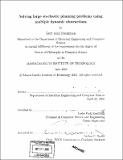| dc.contributor.advisor | Leslie Pack Kaelbling. | en_US |
| dc.contributor.author | Steinkraus, Kurt Alan, 1978- | en_US |
| dc.contributor.other | Massachusetts Institute of Technology. Dept. of Electrical Engineering and Computer Science. | en_US |
| dc.date.accessioned | 2006-08-25T18:57:34Z | |
| dc.date.available | 2006-08-25T18:57:34Z | |
| dc.date.copyright | 2005 | en_US |
| dc.date.issued | 2005 | en_US |
| dc.identifier.uri | http://hdl.handle.net/1721.1/33928 | |
| dc.description | Thesis (Ph. D.)--Massachusetts Institute of Technology, Dept. of Electrical Engineering and Computer Science, 2005. | en_US |
| dc.description | Includes bibliographical references (p. 165-172). | en_US |
| dc.description.abstract | One of the goals of AI is to produce a computer system that can plan and act intelligently in the real world. It is difficult to do so, in part because real-world domains are very large. Existing research generally deals with the large domain size using a static representation and exploiting a single type of domain structure. This leads either to an inability to complete planning on larger domains or to poor solution quality because pertinent information is discarded. This thesis creates a framework that encapsulates existing and new abstraction and approximation methods into modules and combines arbitrary modules into a 'hierarchy that allows for dynamic representation changes. The combination of different abstraction methods allows many qualitatively different types of structure in the domain to be exploited simultaneously. The ability to change the representation dynamically allows the framework to take advantage of how different domain subparts are relevant in different ways at different times. Since the current plan tracks the current representation, choosing to simplify (or omit) distant or improbable areas of the domain sacrifices little in the way of solution quality while making the planning problem considerably easier. | en_US |
| dc.description.abstract | (cont.) The module hierarchy approach leads to greater abstraction that is tailored to the domain and therefore need not give up hope of creating reasonable solutions. While there are no optimality guarantees, experimental results show that suitable module choices gain computational tractability at little cost to behavioral optimality and allow the module hierarchy to solve larger and more interesting domains than previously possible. | en_US |
| dc.description.statementofresponsibility | by Kurt Alan Steinkraus. | en_US |
| dc.format.extent | 172 p. | en_US |
| dc.format.extent | 9775117 bytes | |
| dc.format.extent | 9782337 bytes | |
| dc.format.mimetype | application/pdf | |
| dc.format.mimetype | application/pdf | |
| dc.language.iso | eng | en_US |
| dc.publisher | Massachusetts Institute of Technology | en_US |
| dc.rights | M.I.T. theses are protected by copyright. They may be viewed from this source for any purpose, but reproduction or distribution in any format is prohibited without written permission. See provided URL for inquiries about permission. | en_US |
| dc.rights.uri | http://dspace.mit.edu/handle/1721.1/7582 | |
| dc.subject | Electrical Engineering and Computer Science. | en_US |
| dc.title | Solving large stochastic planning problems using multiple dynamic abstractions | en_US |
| dc.type | Thesis | en_US |
| dc.description.degree | Ph.D. | en_US |
| dc.contributor.department | Massachusetts Institute of Technology. Department of Electrical Engineering and Computer Science | |
| dc.identifier.oclc | 67299107 | en_US |
